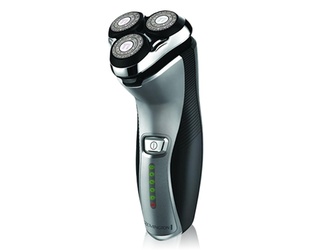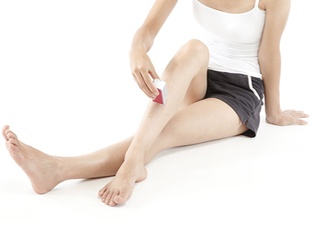Electric Shaver Buying Guide
Electric shavers can provide just as smooth a shave as traditional razors, and they are certainly more convenient. But if you’ve yet to make the switch, transitioning from traditional to electric may present some obstacles—you’re attached to your favorite razor, for example, or worry that you might not get as close a shave with one of those newfangled gizmos.
The variability of electric shavers can also seem daunting to newcomers. Wet or dry? Foil or rotary? What about laser-guided missiles?
This electric shaver guide will help you shop with confidence. We’ll show you how each type of electric shaver works, which is suitable for your hair type, and how it will impact your grooming routine.
Why Go Electric?

- It’s faster. Most electric shavers work more quickly than traditional razors. Plus, they don’t require continual rinsing as you shave.
- It’s simpler. All you really need to shave is the electric shaver itself. Skipping shaving cream streamlines the work and frees up space in the medicine cabinet.
- It’s easier to travel with. Many electric shavers come with a travel bag that’s easy to toss in your luggage. Most work while dry, so you can get ready for a meeting or a friend’s wedding just about anywhere with a mirror.
- It’s convenient. Disposable razors become one less thing to shop and shell out for. Though some parts may have to be replaced over time—the foils, for example—electric shavers typically require less maintenance and fewer continued costs than disposable razors.
- It’s kinder to your skin. Since their blades don’t make direct contact, electric shavers pose a much lower risk of cuts, nicks, and ingrown hairs than a traditional razor or medieval broadsword.
What Kind Should I Choose?
Though electric shavers look high-tech, especially in TV commercials, they’re actually quite simple. Men’s and women’s shavers come in just two types: foil and rotary. Each has a distinct cutting style and recommended uses.
Foil vs. Rotary: What’s the Difference?
Foil shaver

- How it cuts: Foils are thin metal strips that cover the shaving head. They’re perforated with tiny mesh-like holes that snag individual hairs, which are then sheared by blades running underneath.
- Special types: Some foil shavers flex, which helps maintain consistent contact with skin, resulting in a closer shave. Most women’s shavers are foil.
- Shaving tips: Foil is best applied in an up-and-down motion, like a traditional razor, which makes it adept at shaving clean lines around sideburns and goatees.
Rotary shaver

- How it cuts: A rotary shaver features—go figure—rotating blades that spin behind three to five heads. These heads usually pivot independently of each other in order to move comfortably across textured skin.
- Special types: Some rotary heads are elevated onto a flexing neck, which can make it even easier to navigate transitional spots.
- Shaving tips: Rotary shavers should move in a circular motion across the skin, which can take some adjustment for those used to traditional razors’ up-and-down motion.
Picking the Best Shaver for Your Routine
Foil may be best for you if:
- You shave daily. It cuts closer to skin, and its mesh-like holes are more effective at catching new growth.
- You have fine-to-medium straight hair. Those tiny holes are also great at catching and positioning finer hair. And since foil shavers are designed to be applied with an up-and-down motion, they do well with hair growing in a straight grain.
- You’re a woman. The vast majority of women’s shavers are foil. Women’s hair tends to be finer than men’s, and most women prefer a very close, smooth shave—foil is your best bet on both counts.

Rotary may be best for you if:
- You shave every few days. Though it doesn’t shave quite as close as foil, rotary generally fares better with longer hairs, making it better suited to a few days’ growth.
- Your hair is medium-to-thick or curly. Rotary’s more open design better allows thicker hairs to reach the blades. Also, because rotary shavers move in a circular motion, they tend to be better at cutting coarse grains where hair grows in a divergent pattern.
A hedge trimmer may be best for you if:
- You are a bush or shrub, planted to provide a tidy but substantial boundary around a home.
Regional Shaving Tips
When starting out with an electric shaver, it may take a while to adjust to its cutting style. As with traditional razors, you’ll figure out how much pressure to apply, and which angle and direction best cuts your hair’s unique grain. Here are some tips to make the switch even easier:
Gents

- Goatees, sideburns, and detail work: Consider a shaver with a pop-up trimmer, which helps mow clean edges and makes it easier to do detailing, such as carving hot-rod flames into your stubble.
- Beard and neck hair: Rotary shavers typically move better over the changing terrain and divergent growth patterns between the jawline and neck. That’s not to say foil can’t do the job. If using foil, simply pay close attention to the grain of your whiskers so that you’re maximizing the results of each movement. Too many passes can lead to irritation.
- Head: Most electric shavers are designed for and tested on the face. However, should you dress as Uncle Fester for Halloween, the same rules apply to shaving your head. Be patient as you navigate the transition from the top of your head to the back and sides, especially if you have a double crown.
Ladies

- Legs: Because of their large surface area and sometimes frequent shaving requirements (think summertime), legs are ideal candidates for the convenience of electric shavers. Just as with razors, it can be difficult to navigate the ankles and knees, so work with care.
- Sideburns, brows, and other facial hair: Apply gentle pressure, and be sure that your shaver is designed specifically for the face. Some shavers come with extra trimming tools that afford more precise control over tighter regions.
- Bikini line: As with facial hair, apply gentle pressure, and be sure that your shaver is designed to shave this region. Consider a wet shaver with shaving cream to reduce friction and bumps.
- Underarms: Some of the most delicate skin on the body, underarms call for a shaver that’s expressly designed for them. This will help prevent razor burn and pinching.

FAQ: Transitioning to Electric Shaving
New to electric shaving? Hesitant to commit to a new electronic after Siri started giving you the silent treatment? We’ve got your back as you make the switch.
Does electric shaving require different prep than a traditional shave?
Yes, but it’s usually simpler. Electric shavers typically work best when hair and skin are dry, so you can nix the pre-shave moisturizers and cleansers. The stiffness makes it easier to catch and shear the hairs.
Do I need after-shave, shave gel, or other products?
Though electric shavers usually require fewer supplementary products, your skin type may need a little coddling, particularly in the first few weeks as you adjust. Pre-shave: Shave enhancers boost the quality of your electric shave. Look for ingredients that help stiffen and raise hair, such as witch hazel, or essential oils that reduce friction—lavender is a good bet. Shave time: Creams and gels can reduce irritation, but they also help skin feel deliciously smooth and simply add an element of ritual to your shave. They work particularly well with wet shavers (check to make sure yours is waterproof first). Post-shave: As any metal-to-skin contact brings some risk of irritation, have moisturizer or witch hazel on hand to soothe skin.
Will I need to replace any parts of the shaver?
Yes, and what needs to be replaced will vary by manufacturer. Every shaver should come with upkeep recommendations. A good rule of thumb is to expect parts will need replacement annually. For example, Panasonic recommends replacing the outer foils on many of its shavers each year, and the inner blades every two years. To make things easier, look for features that simplify maintenance, such as self-sharpening blades.
How do I clean the shaver?
Cleaning an electric shaver is often as easy as popping off the top and brushing out the collected hairs. Some shavers you can even rinse. But don’t get careless. It’s tempting to tap a shaving head to get the hairs out; however, doing so could mean denting the foil or rotary guard, resulting in a dull shave or even nicks.
Can I use the shaver while it’s charging? How long should my battery last?
Sure, though the cord may get in your way. Like many rechargeable batteries, your electric shaver’s battery should last for years so long as it’s stored and cycled properly. Many models recommend a complete discharge before the first charging, and then a repeat of this process once per year. This helps the battery maintain maximum capacity.
What should I do with the time electric shaving will save me?
We hear there’s bank to be made in underground table tennis tournaments. But these are probably illegal.
What kinds of bells and whistles can I get?
- Cordless shavers offer more freedom of movement and can be used anywhere. Just make sure the shaver’s fully charged so it doesn’t give out halfway through the job.
- Travel kits make on-the-go grooming easier. They pack up your shaver along with accessories such as cleaning brushes in a neat little bag.
- Built-in trimmers help with detailing, such as defining sideburns, shaping bikini lines, or adding a dramatic arch to your brows.
- Wet/dry shavers make it easier to shave before, during, or after your shower—the choice is yours. They also work with comfort-enhancing shave creams and gels.
- High-end shavers—those that cost several hundred dollars—add an array of even fancier features. For example, some have all-in-one stations that handle charging, cleaning, and lubricating. For the shaving maestro, and for werewolves.
 Electric Toothbrush Buying Guide
Electric Toothbrush Buying GuideElectric toothbrushes round out morning routines with more power than their traditional counterparts. Here’s everything you need to know to find the right one for you.


